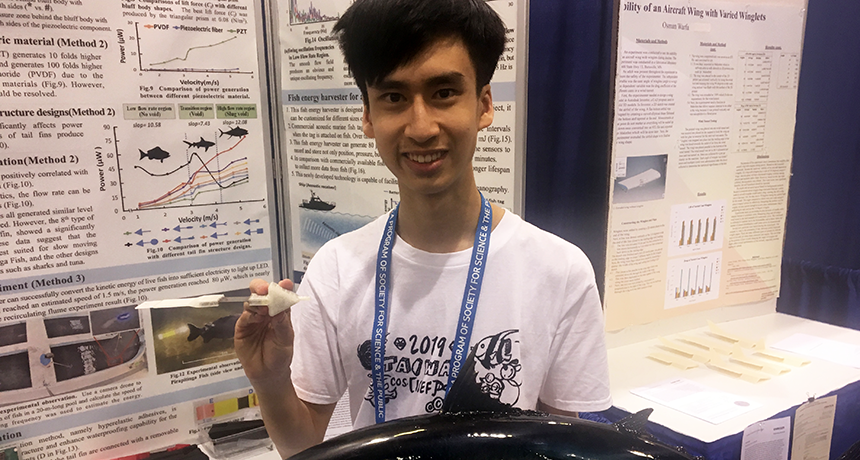This fish ‘tag’ runs on fish power
A teen developed an electrically powered tag that runs on the power provided by a fish’s swimming

Huai-pu Chen shows off his new fish tag (left). The tail of the tag bends in the water as a fish swims, which powers the electronics in the arrow-shaped head of that tag.
B. Brookshire/SSP
PHOENIX, Ariz. — Under the sea, scientists tag fish to track their numbers and learn about the ocean. But those tags have one problem: Their batteries run out of energy. Now, a teen has designed a tag that never loses power as long as its host is alive. All the fish has to do? Just keep swimming.
“I am a big fish fan,” says Huai-pu Chen, 16. “I go fishing and dive almost every day.” Spending so much time around fish, this junior at Keelung Municipal Anle Senior High School in Taiwan began to ponder whether the animals might be able to use their strong swimming for a different type of power.
“When I was little, I saw fish in the ocean. They swam rapidly and energetically and I thought, ‘What if we could use fish to produce energy?’” More recently, Haui-pu wondered if these fish might be able to power the technology in electronic tags.
Scientists tag fish, snakes, sea turtles, whales and more to learn about their lives and the oceans through which they swim. But these tags run on batteries. And batteries don’t last forever.
Huai-pu wanted to see if a fish’s swimming could make a longer-lasting battery. He turned to a special ceramic — a hard, brittle material — that is piezoelectric. Such a material can develop an electric charge when it is bent or squeezed. The teen took bands of piezoelectric ceramics and hooked them up to a tiny capacitor — an electrical component that stores energy. The whole device rests in a 3-D-printed plastic case that is shaped like a small arrow.
The teen hooks his tag just below the dorsal fin on a fish’s back. As the animal swims, the motion of the water around that tag bends the ceramic back and forth. This bending action builds up an electric charge that gets stored in the capacitor. A little more swimming, and the tag can light a small bulb, power a thermometer or measure such things as water depth.
These tests were fishy
Huai-pu first tested his device with a computer model. It simulated how the system might work in the real world. Then, he built his fish tag and tested it in a tank of flowing water. Finally, he went to a fish farm and attached it to a slow-moving fish called a priapitinga.
Even on a slow swimmer, the tag’s motion was sufficient to keep it powered. If attached to a large, speedy fish (such as a tuna), the tag could produce about 90 microwatts of energy, the teen reasons. But even swimming slowly, a fish would produce enough wave action to power the tag. And if it stays powered-up, the current design might allow the tag to operate for 1.5 years. In fact, Huai-pu would like it to make if last for up to 20.
The teen brought his new tag here to the Intel International Science and Engineering Fair. This yearly event brings together more than 1,800 students from 80 countries to show off their research. Created and run by Society for Science & the Public, this year, ISEF is sponsored by Intel. (The Society also publishes Science News for Students.)
Huai-pu has lots of ideas for his tag. “We could [use it to] understand the migration path of fish,” he says. Even more, “the fish in this system could be an ocean exploration system.”
Fish can go places that people can’t, the teen notes. “Scientists can gather data like pressure and temperature from research vessels using sonar,” he says. However, this costs a lot in effort and money.” His new tags cost $400 to build, far less than a research ship. If he could tag many fish, all with devices that never ran out of power, “We could get a mass of data at low cost, and change the way human beings explore and research the ocean.”
And all the fish would need to do is swim.







